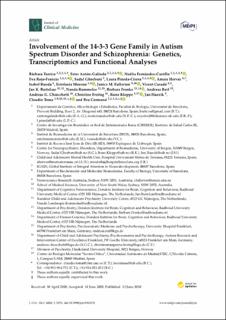Involvement of the 14-3-3 Gene Family in Autism Spectrum Disorder and Schizophrenia: Genetics, Transcriptomics and Functional Analyses
Torrico, Bàrbara; Antón-Galindo, Ester; Fernàndez-Castillo, Noèlia; Rojo-Francàs, Eva; Ghorbani, Sadaf; Pineda-Cirera, Laura; Hervas, Amaia; Rueda, Isabel; Moreno, Estefanía; Fullerton, Janice M.; Casadó, Vicent; Buitelaar, Jan K; Rommelse, Nanda; Franke, Barbara; Reif, Andreas; Chiocchetti, Andreas G; Freitag, Christine; Kleppe, Rune; Haavik, Jan; Toma, Claudio; Cormand, Bru
Journal article, Peer reviewed
Published version

Åpne
Permanent lenke
https://hdl.handle.net/11250/2759346Utgivelsesdato
2020Metadata
Vis full innførselSamlinger
- Department of Biomedicine [710]
- Registrations from Cristin [9791]
Sammendrag
The 14-3-3 protein family are molecular chaperones involved in several biological functions and neurological diseases. We previously pinpointed YWHAZ (encoding 14-3-3ζ) as a candidate gene for autism spectrum disorder (ASD) through a whole-exome sequencing study, which identified a frameshift variant within the gene (c.659-660insT, p.L220Ffs*18). Here, we explored the contribution of the seven human 14-3-3 family members in ASD and other psychiatric disorders by investigating the: (i) functional impact of the 14-3-3ζ mutation p.L220Ffs*18 by assessing solubility, target binding and dimerization; (ii) contribution of common risk variants in 14-3-3 genes to ASD and additional psychiatric disorders; (iii) burden of rare variants in ASD and schizophrenia; and iv) 14-3-3 gene expression using ASD and schizophrenia transcriptomic data. We found that the mutant 14-3-3ζ protein had decreased solubility and lost its ability to form heterodimers and bind to its target tyrosine hydroxylase. Gene-based analyses using publicly available datasets revealed that common variants in YWHAE contribute to schizophrenia (p = 6.6 × 10−7), whereas ultra-rare variants were found enriched in ASD across the 14-3-3 genes (p = 0.017) and in schizophrenia for YWHAZ (meta-p = 0.017). Furthermore, expression of 14-3-3 genes was altered in post-mortem brains of ASD and schizophrenia patients. Our study supports a role for the 14-3-3 family in ASD and schizophrenia.
